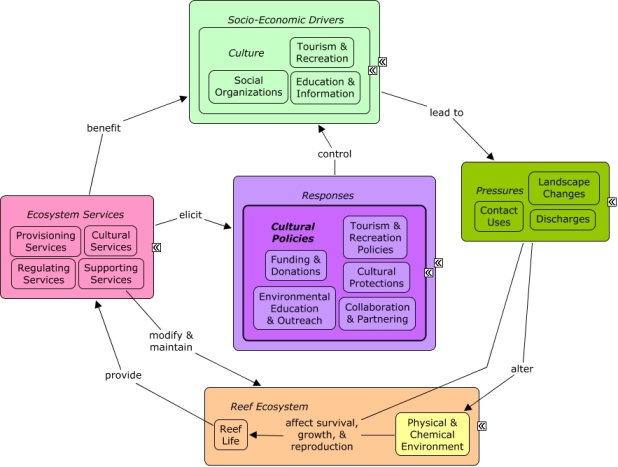ReefLink Database

Cultural Policies
Cultural policies are responses that impact the distribution and functioning of cultural sectors, including tourism, recreation, education, and social organization. Examples include policies to limit or increase tourism, educate the public to enhance environmental awareness, increase funding for scientific research and outreach, or improve the effectiveness of decisions through collaboration and partnering.
CMap

CMap Description
A change in the provision of ecosystem services, or a desire to improve provision of ecosystem services, may elicit responses to manage the distribution and functioning of cultural sectors. Cultural sectors, particularly tourism and recreation, create pressures on the reef ecosystem primarily through contact uses, but also drive coastal development which can lead to landscape changes and increasing pollution. Tourism and recreation policies can be use to control the distribution and intensity of recreational activities through advertising, incentives, or visitors centers. Environmental education and outreach, including classwork, field trips, public advertising campaigns, and brochures, can be used to increase environmental awareness and to teach the public about the value of ecosystem services, or to modify public behavior. Funding and donations can provide monetary support to educational institutions or non-profit organization for scientific research and monitoring, education , or outreach. Collaboration and partnering can improve the effectiveness of monitoring and research by integrating the efforts of academic and government institutions. Cultural protections are designed to preserve or protect buildings, landscapes, or species of cultural or historic significance. Cultural sectors benefit from reef ecosystem services, including recreational and educational opportunities.Citations
More than 50 citations. Click here to load.
| Citation | Year | Study Location | Study Type | Database Topics |
|---|
Management Options
More than 50 management options. Click here to load.
| Management Option | Description | Sources | Database Topics |
|---|
Laws
More than 50 laws. Click here to load.
| Legal Citation | Purpose of Law | Management Organization | Database Topics |
|---|
